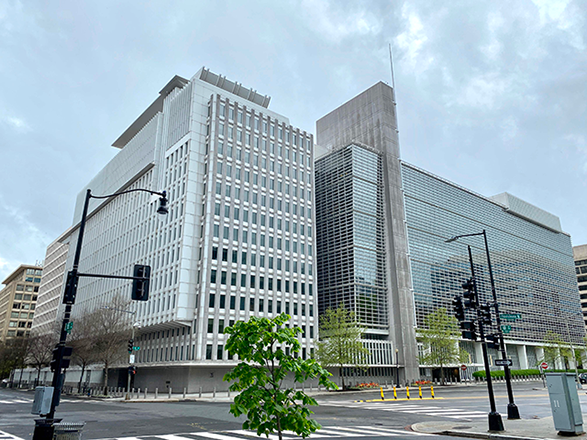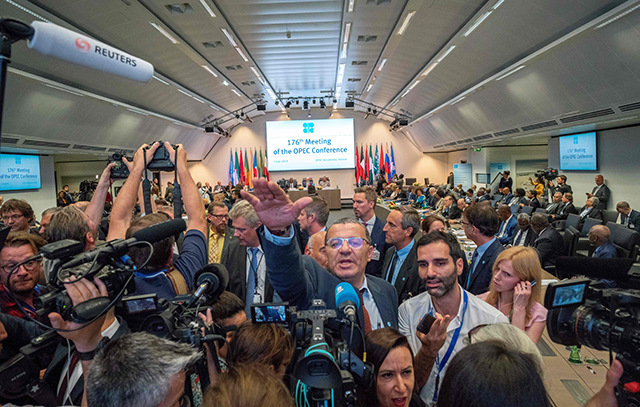You are here
Mideast economy set for worst slump in decades — IMF
By AFP - Apr 14,2020 - Last updated at Apr 14,2020

The World Bank Group building is viewed on an empty street in Washington, DC on April 13, 2020, during the virtual IMF, World Bank Spring 2020 meetings. (AFP photo)
DUBAI — The Middle East and North Africa economy will contract by 3.3 per cent this year, the biggest slump in four decades, hammered by the coronavirus and low oil prices, the International Monetary Fund (IMF) said on Tuesday.
In its World Economic Outlook, the IMF said the damage would be much worse than the region's last major shock, the 2008-09 global financial crisis, when it managed to post modest growth.
The region, which includes all Arab countries and Iran, will suffer its worst economic performance since 1978 when it was convulsed with unrest and shrank by 4.7 per cent, according to World Bank data.
The IMF said that all the Arab countries apart from Egypt will see their gross domestic product (GDP) fall this year.
Saudi Arabia, the region's heavyweight which is just emerging from an oil price war with Russia that saw crude prices crash, is headed for a 2.3 per cent contraction.
"The fast deterioration of the global economic outlook as the epidemic has spread and the breakdown of the OPEC+ agreement among oil suppliers have weighed heavily on commodity prices," the global lender said.
Its report was prepared before the OPEC+ grouping -- which takes in OPEC producers and allies -- reached agreement on Sunday to cut output by nearly 10 million barrels per day, the largest in history.
From mid-January to end-March, oil prices dropped by 65 per cent or $40 a barrel and natural gas prices declined by 38 per cent, the IMF said.
It also projected prices to remain below $45 a barrel through 2023, around 25 per cent below the average last year.
'Extreme uncertainty'
Arab countries, which have reported more than 20,000 coronavirus cases along with over 700 deaths, have resorted to sweeping lockdowns and curfews to prevent the spread of the disease, disrupting local economies.
Years of bloody conflicts in several Arab countries including Syria, Yemen, Iraq and Libya have already battered their economies and created widespread poverty.
Many Middle Eastern countries, notably the Gulf states plus Iraq and Iran, depend heavily on oil revenues to finance their budgets.
"These developments are expected to weigh heavily on oil exporters with undiversified revenues and exports," said the IMF, adding that lower oil prices will meanwhile benefit oil-importing nations.
The IMF said that the latest oil output cut will further dampen the prospects of the Saudi economy, which grew by just 0.3 per cent in 2019.
The United Arab Emirates' economy, the most diversified in the region, is projected to contract by 3.5 per cent, while Qatar, the third-largest in the Gulf, is expected to slide 4.3 per cent.
Iran's economy, the second largest in the Middle East, is forecast to shrink 6.0 per cent in 2020 for its third contraction in a row. In 2018 and 2019, it shrank by 3.6 per cent and 7.6 per cent respectively.
Iran has been hit hard by the coronavirus, reporting more than 73,000 cases and 4,585 deaths.
The economy of Lebanon, which has defaulted on its mountain of debt, is expected to contract by a massive 12 per cent, while Iraq, OPEC's second-largest producer, is headed for a fall of 4.7 per cent.
Only Egypt is projected to stay in positive territory with 2.0 per cent growth although that is way down from the 6.0 per cent projected before the coronavirus crisis hit.
As a whole, the Middle East and North Africa economy, which grew by just 1.0 per cent last year, is projected to rebound by 4.2 per cent in 2021, the report said.
But the IMF noted that "extreme uncertainty" surrounds its forecast because the economic fallout of the pandemic depends on factors that are hard to predict -- including the pathways of the disease and the intensity of containment efforts.
Related Articles
DUBAI — Saudi Arabia's gross domestic product (GDP) will shrink by 6.8 per cent this year, its worst performance since the 1980s oil glut, a
PARIS — The coronavirus outbreak will slash global oil demand in 2020 to erase a decade of growth and set up "the worst year in the history"
LONDON — Top oil producers were scheduled to discuss on Thursday a possible cut in output after a collapse in demand due to the coronavirus

















